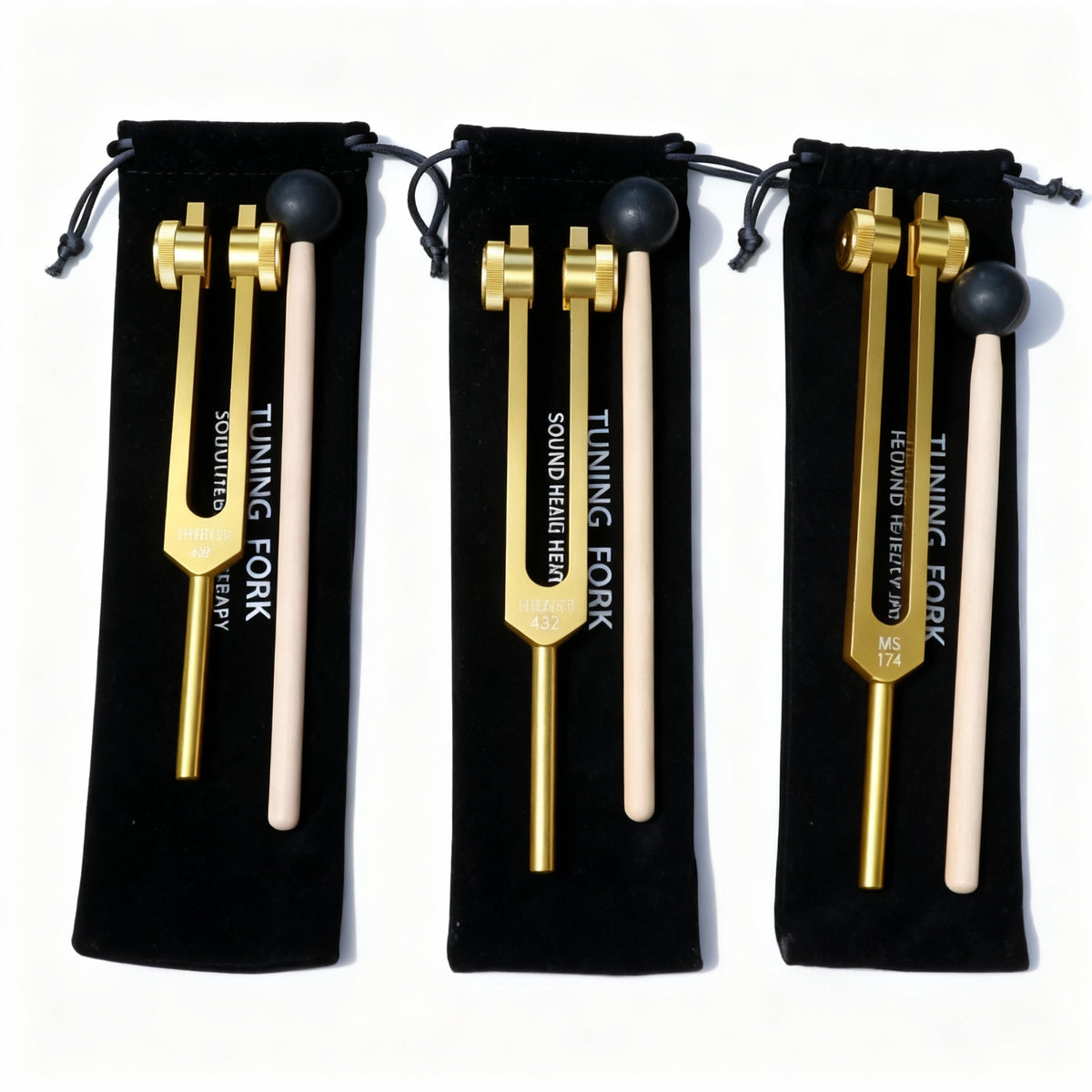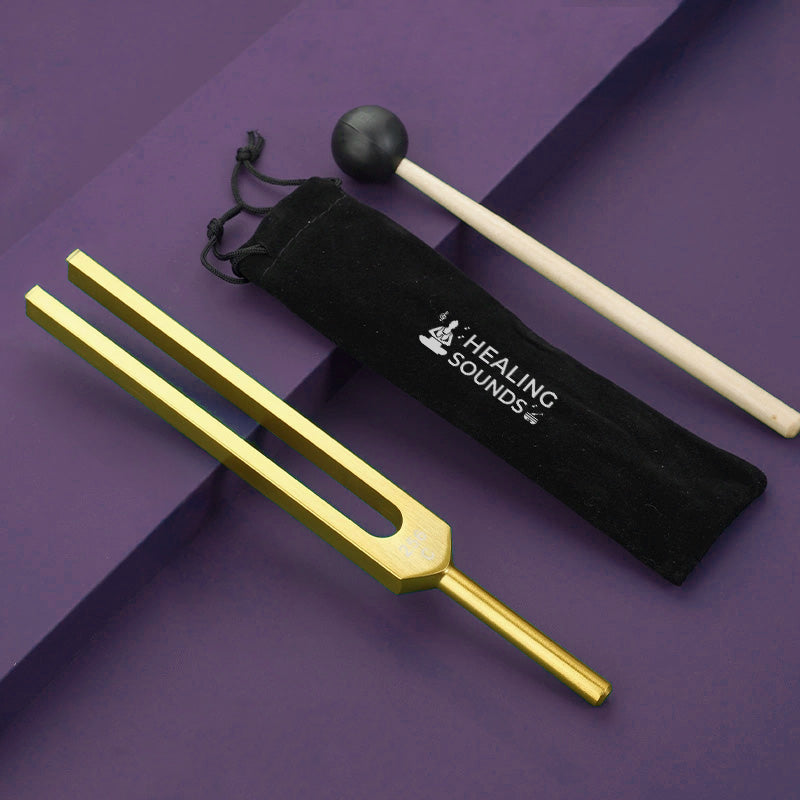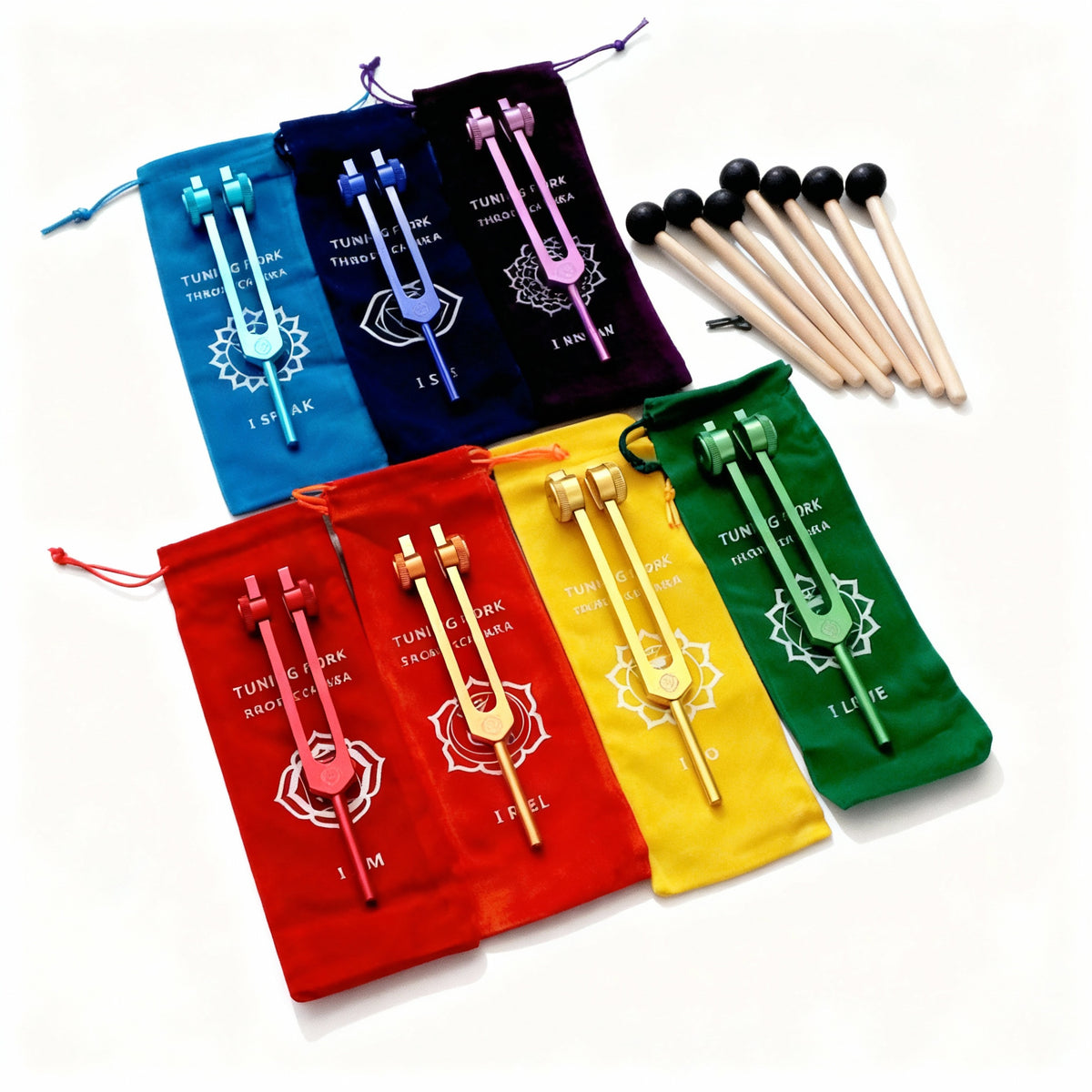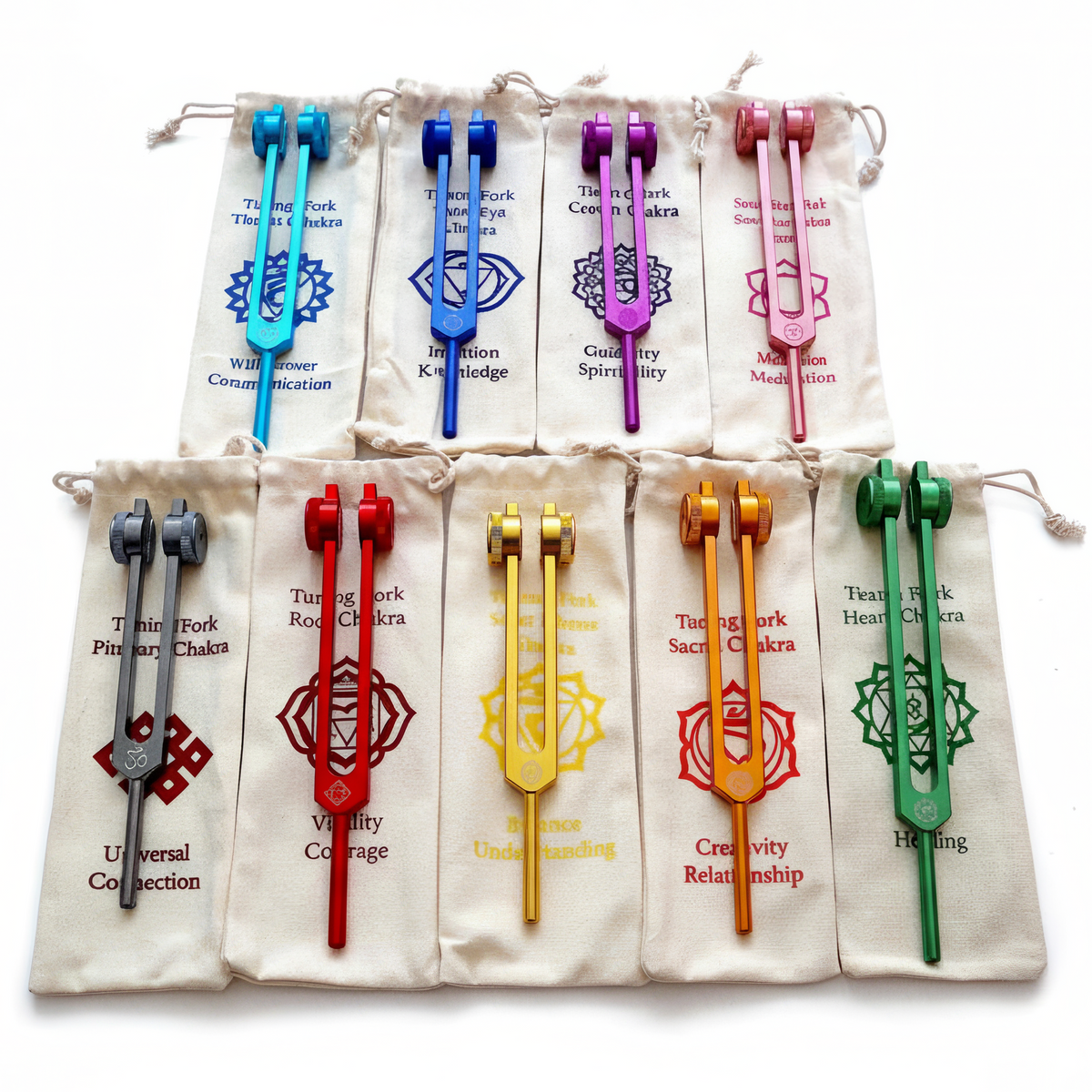Are you curious about how specific sounds can promote relaxation, balance your energy, or even support physical well-being? Welcome to the fascinating world of tuning fork frequencies. At Healing Sounds, we understand that sound is more than just hearing; it's a powerful tool for transformation. This guide will explore the diverse spectrum of frequencies used in sound therapy, from grounding Earth tones to uplifting Solfeggio vibrations, helping you understand how to harness their potential for chakra alignment and holistic health. Discover the difference between weighted tuning forks and unweighted tuning forks and find the perfect frequency for your wellness journey.
What Exactly Are Tuning Fork Frequencies?
A tuning fork is a simple yet precise instrument designed to vibrate at a specific, constant pitch when struck. This pitch, measured in Hertz (Hz), represents the number of vibrations per second and is known as the tuning fork frequency. In sound therapy, these specific frequencies are used to interact with the body's natural vibrations.
The principle behind this is resonance – the tendency of a system to vibrate with greater amplitude at specific frequencies. When a tuning fork is activated and placed near or on the body, its vibrations can encourage the body's cells, tissues, and energy centers (like chakras) to resonate sympathetically, potentially restoring balance and promoting healing.
⚠️ Why Frequency Precision Matters
Not all tuning forks deliver therapeutic results. A 528 Hz fork calibrated to 523 Hz or 533 Hz will not provide the intended healing benefits. This is why choosing a reputable supplier is crucial.
Professional-Grade Calibration: Quality forks should be calibrated to ±0.25 Hz accuracy using CNC-machining and computer verification. Look for suppliers who laser-engrave the exact frequency on each fork and guarantee tuning stability for years—ensuring you receive the genuine therapeutic effects you're seeking.
Weighted vs. Unweighted Tuning Forks
Understanding the difference is key:
- Weighted tuning forks: These have weights added to the ends of the prongs. This results in a stronger vibration that is felt more intensely and lasts longer. They are excellent for applying directly to the body on muscles, joints, or acupressure points for targeted physical relief.
- Unweighted tuning forks: Lighter and producing a clearer, purer tone with less felt vibration, these are typically used off the body, in the energy field or 'biofield' surrounding a person. They are ideal for chakra alignment, energy clearing, and creating relaxing sound baths.
Note: Weighted forks are typically tuned to a lower octave (divided by 2 to 8 depending on the frequency) to optimize tactile resonance on the body—lower frequencies travel deeper and feel smoother on contact while preserving the same energetic signature.

136.10 Hz Weighted Tuning Fork with Crystal Handle
Experience the profound grounding and heart-opening 'OM' frequency (136.10 Hz) with this weighted fork, perfect for meditation and heart chakra alignment.
Explore the OM ForkThe Science Behind Sound Healing with Frequencies
While deeply rooted in ancient practices, the therapeutic use of sound is also gaining attention in modern science. The concept of the biofield – a subtle energy field thought to surround and permeate living organisms – is central to understanding how tuning fork frequencies might work. Some researchers propose that disruptions in this field correlate with physical or emotional imbalances.
Applying specific frequencies may help to restore coherence within the biofield. Studies exploring music therapy and sound healing suggest potential benefits for stress reduction, pain management, and mood improvement. The vibrations produced by tuning forks may interact with the body on a cellular level, influencing physiological processes through mechanical stimulation and resonant frequencies. For more on the biofield concept, explore resources like this review on biofield science.
Exploring Key Tuning Fork Frequencies and Their Uses
Different frequencies are believed to have unique effects on the body and mind. Here are some of the most commonly used categories in sound therapy:
Chakra Alignment Frequencies
Chakras are energy centers within the body, each associated with specific physical, emotional, and spiritual functions. Using corresponding chakra tuning fork frequencies can help balance these centers. These frequencies derive from planetary orbital cycles, connecting cosmic rhythms to our body's energy system:
- Root Chakra (Muladhara): 194.18 Hz (Earth frequency) - Grounding, lower back pain relief, leg circulation, feeling safe and secure.
- Sacral Chakra (Svadhisthana): 210.42 Hz - Hip tension release, reproductive health support, creativity blocks, emotional flow restoration.
- Solar Plexus Chakra (Manipura): 126.22 Hz - Digestive issues, core strength, personal power reclamation, confidence building.
- Heart Chakra (Anahata): 136.10 Hz (OM/Jupiter frequency) - Chest tightness relief, breathing ease, emotional healing, compassion cultivation. Often targeted with a healing tuning fork.
- Throat Chakra (Vishuddha): 141.27 Hz - Neck tension, communication blocks, self-expression enhancement.
- Third Eye Chakra (Ajna): 221.23 Hz - Headache relief, mental clarity, intuition awakening, focus improvement.
- Crown Chakra (Sahasrara): 172.06 Hz - Head pressure relief, spiritual connection, mental peace.
Harmonize all seven energy centers with planetary frequencies designed for complete energetic alignment—from grounding to spiritual connection.
Solfeggio Frequencies: Tones for Transformation
The Solfeggio scale is an ancient musical scale associated with spiritual blessings and healing. The complete system includes 6 original sacred frequencies plus 3 additional tones for comprehensive healing:
- 174 Hz: Pain relief and muscle tension release—particularly effective for chronic pain conditions.
- 285 Hz: Tissue regeneration and healing acceleration—supports ligament and tendon recovery.
- 396 Hz: Liberating guilt and fear—releases survival-based anxiety and trauma patterns.
- 417 Hz: Undoing situations and facilitating change—clears emotional blockages.
- 528 Hz: Transformation and miracles (the 'Love Frequency')—associated with DNA repair and cellular healing.
- 639 Hz: Connecting relationships and harmony—heart-centered connection.
- 741 Hz: Awakening intuition and expression—clearing communication blocks.
- 852 Hz: Returning to spiritual order—opening higher consciousness.
- 963 Hz: Divine connection and spiritual integration—pineal gland activation.
Clinical Applications of Solfeggio Frequencies
Sound therapy can support healing when used alongside professional treatment:
For Chronic Pain & Physical Recovery: 174 Hz, 285 Hz, and 396 Hz work synergistically to address pain, tissue repair, and the emotional patterns often underlying physical tension. Many practitioners combine these with weighted tuning forks for bone and muscle therapy.
For Trauma & PTSD Support: The 396-528-741-963 Hz sequence helps process stored trauma—releasing fear (396 Hz), restoring emotional balance (528 Hz), clearing expression blocks (741 Hz), and integrating spiritual connection (963 Hz). These frequencies serve as supportive tools within a comprehensive healing approach guided by professionals.
💡 Weighted vs. Unweighted Solfeggio Sets
Weighted Solfeggio Sets deliver the same sacred frequencies tuned to lower octaves for direct body application—ideal for somatic release, pain relief, and physical healing work.
Unweighted Solfeggio Sets work in the biofield and auditory range—perfect for meditation, space clearing, and energetic balancing. Many practitioners use both complementarily: weighted for grounding physical work, unweighted for expanding into the energy field.
For an overview of these frequencies, consider resources like this introduction to Solfeggio Frequencies.
Complete 9-frequency sets (weighted and unweighted) combining the 6 original sacred tones with 3 additional frequencies for comprehensive healing—from pain relief to spiritual awakening.
How to Use the 528 Hz Tuning Fork for Healing
The 528 Hz frequency is perhaps the most famous Solfeggio tone. To use it for healing, activate an unweighted 528 Hz tuning fork and gently sweep it through the energy field around the body, focusing on areas needing balance or healing intention. You can also hold it near the heart chakra to promote feelings of love and peace, or simply listen to its tone during meditation to encourage a state of transformation.

3pc Solfeggio Tuning Fork Set: 174, 432 & 528 Hz
Perfect starter set combining pain relief (174 Hz), grounding (432 Hz), and transformation (528 Hz). Experience the core healing frequencies in weighted format for direct body application. ⚠️ Popular choice - often restocks within 2-3 weeks due to high demand.
Explore 3pc Solfeggio SetHarmonic and Scientific Frequencies
Some frequencies are based on harmonic principles or scientific measurements. Understanding what makes frequencies "harmonic" unlocks deeper therapeutic potential:
What Makes Frequencies Harmonic?
Harmonic tuning forks create musical intervals that naturally resonate together, based on precise mathematical ratios:
- Octaves (1:2 ratio): Example: 128 Hz + 256 Hz. The fundamental relationship where one frequency is exactly double the other, creating perfect unity and grounding.
- Perfect Fifth (2:3 ratio): Example: 256 Hz + 384 Hz. This interval balances masculine and feminine energies (Yin/Yang) and is considered one of the most consonant, healing sounds in music.
- Major Third (4:5 ratio): Example: 256 Hz + 320 Hz. Creates uplifting, joyful resonance.
When played together, harmonic frequencies create consonant, pleasing sounds that amplify each other's healing effects and generate rich overtones filling the space—perfect for sound baths and group sessions. For example, the 256-320-384-512 Hz set forms a C Major chord (C-E-G-C).
256 Hz (Scientific C): A frequency based on mathematical and physical principles, often used in scientific and musical contexts. It's considered grounding and balancing. A 256 Hz tuning fork is often used as a reference tone or for general relaxation.
512 Hz: An octave higher than 256 Hz, this frequency is sometimes used in neurological exams (Rinne test) and is known for its clear, bright tone. A 512 Hz tuning fork can be used for clearing energy or enhancing mental clarity.
Explore Harmonic and Specialized Tuning Forks

Professional Otto Tuners Weighted 4 Tuning Forks Set
$99.90
$129.90
Experience deep relaxation with these weighted tuning forks (32, 48, 64, 128 Hz) in perfect octave harmony—ideal for applying directly to the body to release tension and promote grounding. Learn more ➔

256 Hz 320 Hz 384 Hz 512 Hz Tuning Fork Set
$59.90
$79.90
The perfect C Major chord (C-E-G-C) combining Scientific C (256 Hz), Major Third (320 Hz), Perfect Fifth (384 Hz), and octave (512 Hz)—great for beginners exploring harmonic sound therapy. Learn more ➔

Adjustable 64 Hz - 128 Hz Tuning Fork
$49.90
$79.90
Versatile weighted fork switching between 64 Hz and 128 Hz (perfect octave)—two essential grounding frequencies in one tool for body work and nervous system regulation. Learn more ➔

Yin Yang Tuning Fork Set (256 Hz & 384 Hz)
$59.90
$129.90
Experience the perfect fifth interval (2:3 ratio) that balances masculine and feminine energies. This harmonic pair creates consonant resonance ideal for restoring energetic equilibrium and spiritual balance. Learn more ➔
High-Frequency Angel Tuners
At the opposite end of the spectrum, Angel Tuners (4096 Hz, 4160 Hz, and 4225 Hz) operate at ultra-high frequencies designed to connect you to higher spiritual realms and angelic energies. These ethereal tones promote:
- Mental Clarity & Focus: High frequencies cut through mental fog and enhance concentration.
- Spiritual Connection: Opens channels to higher consciousness and intuitive guidance.
- Space Clearing: Purifies environments of stagnant or heavy energy.
- Deep Peace: Creates a serene, meditative atmosphere ideal for spiritual exploration.
Many practitioners use Angel Tuners as "finishing touches" after chakra or Solfeggio work—they're beautiful additions for clarity and uplift. Explore our Angel Tuner sets for meditation and energy clearing.
Low Frequency Otto Tuners
Otto tuners vibrate at lower frequencies (e.g., 32 Hz, 64 Hz, 128 Hz) and are typically weighted. These deep vibrations are excellent for promoting relaxation, easing muscle tension, soothing joint pain, and grounding the body's energy. They are often applied directly to the sternum, vertebrae, or large muscle groups.

Otto C 128 Hz Tuning Fork for Sound Healing
The classic weighted fork for deep tissue work. 128 Hz is the most versatile low-frequency tool—perfect for joint pain relief, nervous system regulation, and grounding practices. A must-have for any practitioner's toolkit.
Explore Otto C 128 HzHow to Choose the Right Tuning Fork Frequency
Selecting the right frequency depends on your intention. Ask yourself:
- What is my goal? (Relaxation, energy clearing, specific chakra work, physical discomfort relief?)
- Am I working on the physical body or the energy field? (Weighted forks for physical application, unweighted for energetic work.)
- Am I drawn to a specific system? (Chakras, Solfeggio, Planetary, specific scientific frequencies?)
For beginners, a basic Chakra set or the OM (136.10 Hz) fork is a great starting point. If focusing on physical relaxation, consider an Otto Tuner like 128 Hz. For spiritual exploration, the Solfeggio frequencies, particularly 528 Hz, are popular choices. Ultimately, intuition plays a role – sometimes you might simply be drawn to a particular sound or its described benefits.
Using Tuning Forks Effectively: Basic Techniques
- Activation: Gently tap the tuning fork against a rubber activator puck, the palm of your hand (for unweighted), or your knee (use caution). Avoid striking hard surfaces, which can damage the fork and alter its frequency.
- Application (Unweighted): Hold the activated fork by its stem and move it through the air 3-6 inches away from the body, focusing on chakras or areas needing energetic attention. Listen to the tone.
- Application (Weighted): Hold the activated fork by its stem and place the base of the stem directly onto the body (e.g., joints, muscles, sternum). Allow the vibration to transfer.
- Intention: Hold a clear intention for healing or balance while using the tuning fork.
Experiment with different frequencies and techniques to discover what resonates best with you or your clients. Note: All Healing Sounds tuning fork purchases include a complimentary comprehensive PDF guide with detailed techniques, protocols, and care instructions to support your practice—plus a free healing bracelet with every order.
Conclusion: Harmonize Your Life with Sound
Exploring tuning fork frequencies opens a door to profound possibilities for healing and self-discovery. From the grounding resonance of Otto tuners to the transformative potential of 528 Hz and the precise balancing of chakra tuning forks, sound provides a unique pathway to harmonize mind, body, and spirit. Whether you're using weighted tuning forks for physical relief or unweighted tuning forks for subtle energy work, understanding these vibrational tools empowers your sound therapy practice.
At Healing Sounds, we are dedicated to providing high-quality, precision-calibrated tuning forks crafted from durable materials to support your journey into holistic wellness. Explore our collection and find the frequencies that resonate with your unique path to balance and well-being.
Your Perfect Tuning Fork is Waiting
We know choosing the right frequency is a personal journey. If you have any questions, our team of certified sound healers (with 15+ years experience) is happy to provide a free, personalized email consultation to help you find the perfect match for your practice.
Request a Personal ConsultationFrequently Asked Questions about Tuning Fork Frequencies
Tuning forks come in a wide range of frequencies, each measured in Hertz (Hz). Common categories include Chakra frequencies (e.g., 136.10 Hz for Heart), Solfeggio frequencies (e.g., 528 Hz for transformation), Planetary frequencies (based on celestial body orbits), scientific frequencies (e.g., 256 Hz, 512 Hz), and low frequencies like those used in Otto Tuners (e.g., 128 Hz) for physical relaxation.
Activate the 528 Hz tuning fork (typically unweighted) and hold it by the stem. You can sweep it through the body's energy field (aura), hold it near specific areas needing attention, or focus its sound near the heart chakra to promote love and positive transformation. Listening to the tone during meditation while holding a healing intention is also a common practice.
The 256 Hz tuning fork, often called 'Scientific C', is used for its grounding and balancing properties. It serves as a fundamental note in physics and music theory. In sound therapy, it can be used for general relaxation, centering oneself, clearing mental fog, or as a starting point before using other frequencies.
The 512 Hz tuning fork (an octave above 256 Hz) has a clear, bright tone. It's sometimes used in medical hearing tests. In holistic practices, it's often utilized for clearing stagnant energy, enhancing mental clarity, uplifting mood, and can be incorporated into sound baths for its resonant quality.
There isn't one single "correct" frequency; the ideal tuning fork frequency depends entirely on your intended use. For physical relaxation and pain relief, lower frequencies (like 128 Hz from Otto Tuners) using weighted tuning forks are often preferred. For chakra alignment or energy work, specific chakra or Solfeggio frequencies (using mostly unweighted tuning forks) are chosen based on the energy center or goal (e.g., 136.10 Hz for heart, 528 Hz for transformation).







2 comments
Kyle Callan
Do you teach how to create tuning forks?
Roda
I have a Healing Sounds tuning fork. It says Healing Sounds on one side and Crystal on the other side. What is its frequency, please? Thank you